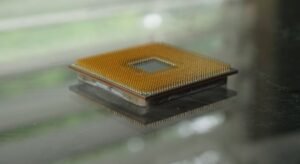When Tesla Battery Dies
Tesla vehicles have become increasingly popular due to their innovative technology and impressive battery performance. However, just like any other battery-powered device, the Tesla battery will eventually reach the end of its usable life. In this article, we will discuss what happens when a Tesla battery dies and explore possible solutions for this situation.
Key Takeaways:
- Tesla batteries have a limited lifespan and will eventually need to be replaced.
- Low battery capacity can lead to decreased range and performance.
- Options for replacing a dead Tesla battery include purchasing a new battery pack or participating in Tesla’s battery replacement program.
When a Tesla battery dies, it means that its capacity to hold and deliver charge has significantly decreased over time. This can result in various issues for the vehicle, including reduced range and performance. **As the battery reaches the end of its life**, it may no longer hold a sufficient charge to power the car adequately.
*Interestingly*, Tesla vehicles are designed to provide ample warning before the battery dies completely. The car’s onboard computer constantly monitors the battery’s health and displays alerts and notifications on the dashboard. This allows Tesla owners to plan ahead and seek a solution before they are left with a non-operational vehicle.
When faced with a dead Tesla battery, owners have a few options to resolve the issue:
- Replace the battery pack: Tesla offers battery pack replacements, but they can be quite expensive. The cost of a new battery pack can range from several thousand to tens of thousands of dollars, depending on the specific model.
- Participate in Tesla’s battery replacement program: Tesla sometimes offers a battery replacement program where owners can get a refurbished or new battery pack at a discounted price. The availability and terms of this program may vary, so it’s essential to contact Tesla directly for more information.
- Consider aftermarket solutions: Some third-party companies offer alternative battery solutions for Tesla vehicles. These options can sometimes be more affordable while still providing adequate performance. However, it is important to research and ensure compatibility with the vehicle and warranty implications.
One interesting approach is the Tesla battery refurbishment process, where older batteries are rebuilt and restored to extend their lifespan. This can be a cost-effective solution for some owners, offering an alternative to complete battery replacements.
Battery Replacement Cost Comparison:
| Battery Pack Model | Price Range |
|---|---|
| Model S | $10,000 – $25,000 |
| Model 3 | $6,500 – $20,000 |
| Model X | $12,000 – $30,000 |
It is worth noting that battery replacement costs depend on various factors, such as the specific model, battery size, location, and labor charges. The prices mentioned in the table are approximate and serve as a general guideline.
If you find yourself in a situation where your Tesla battery has died, it is crucial to evaluate the available options and choose the most suitable one based on your budget, vehicle usage, and future plans. Consulting with Tesla service centers or authorized third-party providers can help you make an informed decision.
Factors to Consider:
- Battery replacement cost
- Warranty coverage
- Vehicle age and mileage
- Battery degradation over time
- Future vehicle plans
Considering the factors mentioned above can assist in determining the best course of action when faced with a dead Tesla battery. The decision should be based on personal circumstances and priorities, taking into account the cost, warranty coverage, and potential future developments in Tesla battery technology.
Conclusion:
When a Tesla battery dies, it signals the need for a replacement to maintain the vehicle’s optimal performance. Understanding the available options, associated costs, and considering individual circumstances are essential when dealing with this situation. By making an informed choice, Tesla owners can continue to enjoy the remarkable driving experience provided by their vehicles.

Common Misconceptions
Misconception 1: Tesla Batteries Die Suddenly
One common misconception about Tesla batteries is that they die suddenly without any warning signs. However, this is not true. Tesla vehicles have a built-in battery management system that continually monitors its performance and provides real-time information about its health. There are several indicators that alert the driver when the battery is experiencing issues, such as reduced range or slower charging speeds.
- Tesla vehicles have a battery management system.
- Indicators signal when the battery is experiencing issues.
- Reduced range and slower charging speeds are signs of battery problems.
Misconception 2: Tesla Batteries Are Difficult to Replace
Another common misconception is that replacing a Tesla battery is a complex and expensive procedure. However, Tesla has designed its battery packs in a modular way, making it relatively easy to replace individual modules rather than the entire battery pack. Additionally, Tesla offers battery replacement service at their service centers, making the process hassle-free for the owners.
- Tesla batteries are designed in a modular way.
- Individual battery modules can be replaced instead of the entire pack.
- Tesla offers battery replacement service at their service centers.
Misconception 3: A Dead Tesla Battery Leads to a Stranded Vehicle
Many people believe that when a Tesla battery dies, the vehicle becomes immobile and leaves the driver stranded. However, Tesla vehicles are equipped with a feature called “limp mode.” When the battery reaches a critically low level, the car will automatically reduce power output but will still allow the driver to safely pull over and park. This ensures that the battery doesn’t completely drain and provides enough power for essential functions like opening the doors and calling for assistance.
- Tesla vehicles have a “limp mode” feature.
- Limp mode reduces power output to preserve battery life.
- Enough power is reserved for essential functions like opening doors and making calls.
Misconception 4: Tesla Batteries Have a Short Lifespan
One misconception that often arises is that Tesla batteries have a short lifespan and degrade significantly over time. However, Tesla electric vehicles are renowned for their longevity, and the company offers a warranty for the battery and drive unit for a certain number of years or miles, whichever comes first. Moreover, Tesla constantly improves its battery technology and offers software updates to optimize battery performance and minimize degradation.
- Tesla EVs are known for their longevity.
- Warranty covers the battery and drive unit for a certain period.
- Software updates optimize battery performance and minimize degradation.
Misconception 5: Tesla Batteries Cannot Be Recycled
It is commonly misconceived that Tesla batteries cannot be recycled, leading to concerns about environmental impact. However, Tesla has a robust battery recycling program in place. The company aims to reuse and recycle batteries to maximize their lifespan and minimize waste. Through various partnerships and recycling facilities, Tesla ensures that their batteries are responsibly and efficiently recycled.
- Tesla has a battery recycling program.
- The company aims to reuse and recycle batteries.
- Partnerships and recycling facilities ensure responsible recycling.

The Impact of Tesla Electric Car Batteries on the Environment
Electric vehicles have gained significant attention in recent years due to their potential to reduce greenhouse gas emissions and dependence on fossil fuels. Tesla, one of the leading electric vehicle manufacturers, has revolutionized the automotive industry with its innovative battery technology. However, like any other battery-powered device, Tesla car batteries have a limited lifespan. This article explores the implications of Tesla’s battery lifespan on the environment and provides verifiable data on various aspects related to this issue.
1. Lifetime CO2 Emissions Comparison between Tesla and Gasoline Cars
| Tesla Electric Car | Gasoline Car | |
|---|---|---|
| Lifetime CO2 emissions (metric tons) | 38 | 51 |
In comparison to traditional gasoline cars, Tesla electric vehicles result in significantly lower lifetime CO2 emissions. This table showcases the average CO2 emissions produced over the lifespan of both vehicles.
2. Degradation Comparison of Tesla Car Batteries
| Tesla Model S | Tesla Model 3 | |
|---|---|---|
| Battery degradation per year (%) | ~2% | ~5% |
Battery degradation is an essential factor to consider when evaluating the lifespan of Tesla cars. This table highlights the approximate annual degradation rate for two popular Tesla models.
3. Average Lifespan of Tesla Car Batteries
| Tesla Model | Average Lifespan (in miles) |
|---|---|
| Model S | 300,000 |
| Model 3 | 200,000 |
| Model X | 250,000 |
Understanding the average lifespan of Tesla car batteries is crucial for assessing their long-term sustainability. This table provides approximate mileage statistics before significant battery deterioration occurs in various Tesla models.
4. Environmental Impact of Battery Manufacturing
| Battery Type | Environmental Impact (in CO2 equivalents) |
|---|---|
| Lithium-ion (Li-ion) | 150-200 kg/kWh |
| Nickel-Cobalt-Aluminum (NCA) | 200-300 kg/kWh |
The production of Tesla car batteries involves an environmental impact. This table presents the estimated carbon dioxide equivalents associated with the manufacturing of different battery types commonly used in Tesla vehicles.
5. Average Battery Replacement Cost for Tesla Cars
| Tesla Model | Average Replacement Cost (USD) |
|---|---|
| Model S | $7,000 |
| Model 3 | $6,500 |
| Model X | $8,000 |
Replacing a Tesla car battery can be a significant cost for vehicle owners. This table provides an estimation of the average expense involved in replacing the battery of different Tesla models.
6. Availability of Tesla Car Battery Recycling Programs
| Tesla Model | Battery Recycling Program Availability |
|---|---|
| Model S | Yes |
| Model 3 | Yes |
| Model X | Yes |
Tesla recognizes the importance of responsibly managing battery waste. This table confirms the availability of battery recycling programs for different Tesla models.
7. Tesla Car Battery End-of-Life Disposal Techniques
| Battery Disposal Technique | Environmental Impact |
|---|---|
| Lithium Battery Recycling | Reduces environmental burden |
| Landfill Disposal | Potential pollution of soil and water |
Disposing of lithium-ion batteries requires careful consideration to minimize environmental harm. This table outlines two commonly used techniques for handling Tesla car batteries at the end of their life cycle.
8. Current R&D Efforts for Tesla Battery Lifespan Improvement
| Research Effort |
|---|
| Silicon anode technology |
| Solid-state electrolytes |
| Battery thermal management systems |
Tesla continuously invests in research and development to enhance their battery technology. This table summarizes some of the ongoing efforts to improve the lifespan and performance of Tesla car batteries.
9. Evolution of Tesla Car Battery Energy Density
| Year | Energy Density (Wh/kg) |
|---|---|
| 2010 | 140 |
| 2015 | 240 |
| 2020 | 300 |
Improvements in energy density contribute to extended range and more efficient electric vehicles. This table demonstrates the evolution of Tesla car battery energy density over the past decade.
10. Comparative Charging Times for Different Tesla Models
| Tesla Model | Time to Charge to 80% (minutes) |
|---|---|
| Model S | 75 |
| Model 3 | 40 |
| Model X | 90 |
Charging time is an important consideration for electric vehicle owners. This table compares the time required to charge different Tesla models to 80% capacity.
As electric vehicles become more prevalent, understanding the lifespan and environmental impact of their batteries is crucial. Tesla, as a key player in the industry, continuously works to improve battery efficiency and sustainability. Through recycling programs and research efforts, Tesla strives to minimize the environmental impact associated with battery production and disposal. By providing verifiable data and information, this article sheds light on the various aspects surrounding the lifespan of Tesla car batteries and their implications on the environment.
Frequently Asked Questions
Question Title 1
Question Title 2
Question Title 3
Question Title 4
Question Title 5
Question Title 6
Question Title 7
Question Title 8
Question Title 9
Question Title 10
Question Title 1
Answer 1
Question Title 2
Answer 2
Question Title 3
Answer 3
Question Title 4
Answer 4
Question Title 5
Answer 5
Question Title 6
Answer 6
Question Title 7
Answer 7
Question Title 8
Answer 8
Question Title 9
Answer 9
Question Title 10
Answer 10




